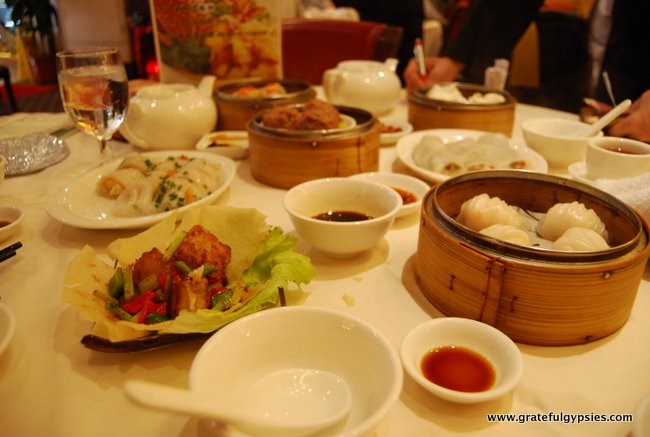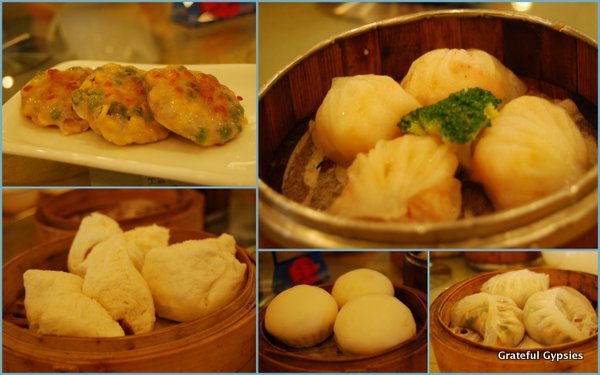Dim Sum Posted by sasha on Aug 1, 2018 in Culture
When it comes to must-try culinary experiences in China, dim sum (点心 – diǎn xīn) is very high on the list. The name of this dish can be translated as “touch the heart,” and a good meal of dim sum does just that. Dim sum is perhaps the best creation of Guangdong cuisine (广东菜 – guǎng dōng cài), which is considered to be one of the Eight Great Culinary Traditions of China. In this post, we’ll learn a bit about dim sum and get some useful Chinese vocabulary so you can order like a local.
An Intro to Dim Sum
In general, dim sum refers to a wide variety of bite-sized portions of food. These are usually steamed, but some are also pan-fried or baked. These little tasty morsels are cooked and ready to be eaten, so waiters just push around carts full of plates to entice you. With so many delicious choices, it’s easy to go overboard when eating dim sum!
Dim sum is typically eaten earlier in the day. It’s also a very popular choice for a later morning meal. People in China don’t really do brunch, per say, but dim sum is about as close as they get. These days, you can also find 24-hour dim sum restaurants that will satisfy your hunger at all hours of the day. I remember ending many a wild night in Beijing at the 3-story dim sum restaurant near Ditan Park. That place is awesome!
Eating dim sum in a restaurant is known in Cantonese as “yum cha” (饮茶 – yǐn chá), which means “to drink tea.” Having a hearty dim sum breakfast with tea is very popular in Hong Kong and other areas of Southern China. This tradition goes way back, when travelers along the Silk Road would stop to rest their weary feet and have a cup of tea. Eventually, tea houses started serving various snacks to go along with the drinks, and thus the tradition of dim sum was born.
Dim sum is basically a variety of different dumplings and steamed buns stuffed full of just about anything, including: beef, chicken, pork, shrimp, and vegetables. One serving usually has about 3 or 4 pieces, so it’s best to go family style and just order up a bunch and pass them around. When out for dim sum, remember that it’s custom to fill your companion’s tea cups before your own. Also, when someone has poured your cup, it’s best to tap your fingers on the table. This is a sign of respect and it will be much appreciated if you know the gesture as a lao wai.
What’s Cooking?
So, what exactly are they pushing around on those carts? Here are a few of the most common dishes you’ll find when eating dim sum:
- shrimp dumpling (虾饺 – xiā jiǎo)
- soup dumplings (小笼包 – xiǎo lóng bāo)
- pot stickers (锅贴 – guō tiē)
- siu mai (烧卖 – shāo mai)
- spring rolls (春卷 – chūn juǎn)
- rice noodle roll (肠粉 – cháng fěn)
- meatballs (牛肉丸 – niú ròu wán)
- steamed pork ribs (蒸排骨 – zhēng pái gǔ)
- BBQ pork bun (叉烧包 – chā shāo bāo)
- pineapple bun (菠萝包 – bō luó bāo)
- taro cake (芋头糕 – yù tou gāo)
- congee/porridge (粥 – zhōu)
- sticky rice (糯米飯 – nuò mǐ fàn)
- egg tart (蛋挞 – dàn tà)
- mango pudding (芒果布甸 – máng guǒ bù diān)
Those are just 15 of the hundreds of tasty treats you may encounter when eating dim sum. It’s best to go to dim sum with a group of people and to show up hungry. With so many delicious options, you’ll probably want to try them all! Now I just have one question for you:
你想吃什么?
nǐ xiǎng chī shén me?
What do you want to eat?

Build vocabulary, practice pronunciation, and more with Transparent Language Online. Available anytime, anywhere, on any device.






Leave a comment: